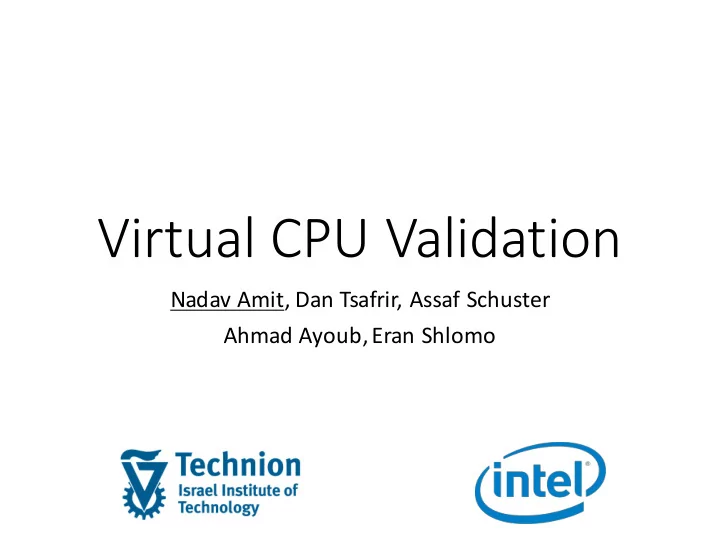

Virtual CPU Validation Nadav Amit, Dan Tsafrir, Assaf Schuster Ahmad Ayoub, Eran Shlomo
Question Your video server freezes once a month. Why? • OS, drivers, BIOS • CPU, hardware • Virus / Hack • Cosmic rays / Power Anything else?
“75% of x86 server workloads are virtualized” [Gartner’15] 80% Virtualized Workloads 60% 40% 20% 0% 2011 2012 2013 2014 2015 Year
Hypervisor Bugs • HW assists virtualization, but SW is still there application • Bug implications: security, stability OS hypervisor • CPU virtualization is hardest, and its bugs have the greatest impact CPU
Real-Life Example • Non-existent register reads leaked host data • Security vulnerability • Patching required reboot
Existing Solutions Micro-hypervisors [Steinberg’10] Reduced trusted-computing base, not hypervisor code Formal Verification [Leinenbach’09] No formal model of CPU Fuzzing [Martigonini’12] No knowledge of CPU semantics
Observation • CPU vendors invest heavily in developing testing tools • 100s of person years or more! • Physical and virtual CPU should behave similarly • So tools for testing physical CPUs should be able to find bugs in virtual CPUs
Contribution 1. Adapt & apply physical CPU testing tools to VCPUs 2. Study hypervisor bugs • Found, fixed, and analyzed >100 bugs
Outline • Motivation • System • Physical CPU testing tools • Adapting tools to VCPUs • Results • Causes of bugs • Impact of bugs • Architectural flaws (as opposed to SW bugs) • Conclusions
Physical CPU Testing Test Initialization Generator Random code & Arch. Sim. Test templates Completion
Physical CPU Testing CPU Test Generator Loader SUT Test Arch. Sim. Debug Res. Tools
Benefits • High coverage • Due to intimate architecture semantic awareness + effort • Low false-positive rate • No undefined results of instructions • No nondeterministic results (due to errata or asyncevents) • Easy to debug • Interim checks • Detailed failure indications • Trace of expected architectural execution
Adaptation: Test Generation • Broken or missing virtualization features Test • Add: • Cache-line monitoring Generator • Performance Monitor Unit v3 Arch. Sim. • … • Workaround: • Nested virtualization • Data breakpoints • …
Adaptation: Execution and Debug • Load tests using hypervisor monitor CPU protocol Test Vloader SUT • Curb OS jitter • Emulate test device for Res. I/O instructions Debug Tools • Enhance debug tools
Effort and Testing Time • Bootstrapping effort • 2 weeks to run the first empty test • 1.5 months to run the first full test • Per-test time • Generation – 5 seconds • Execution – less than a second / 1MB • Failure debugging avg – ~3 hours (high var)
Outline • Motivation • System • Physical CPU testing tools • Adapting tools to VCPUs • Results • Causes of bugs • Impact of bugs • Architectural flaws (as opposed to SW bugs) • Conclusions
Testing KVM: 117 Bugs debug reset 9% 5% task switch 4% model specific registers 7% instruction emulator local 62% APIC 6% other 7%
Instruction Emulator • Why does a hypervisor need an instruction emulator? • Port I/O and Memory Mapped I/O (MMIO) Emulating instructions that access emulated devices • Support for old hardware Restricted guest; shadow page tables • Vendor specific instructions Migration between AMD and Intel • Instruction emulator stress • Emulate every instruction • Run natively if emulation is unsupported
Bug Causes unclear documentation • Mostly due to not 7% following specifications coding • Documentation can errors be improved 15% • Plain coding errors • Races not following specifications • Null dereferences 78% • Wrong error codes • Decimal/Hex
Implications: Security • 6 vulnerabilities • Impact: • Host compromised: 3 host DoS • VM compromised: 2 VM DoS, 1 privilege escalation • Main cause – instruction emulator bugs • x86 ISA consists of 800+ instructions • Usually, many instructions should not be emulated • But the hypervisor can be tricked to emulate them
Implications: Security - Example Exploiting CVE-2015-0239 – potential privilege escalation hypervisor vCPU0 (1) Execute (2) VM-exit (4) Emulate MMIO “buggy” instruction instruction “SYSENTER” “MOV R8, [HPET]” “SYSENTER” “ SYSENTER ” (3) write a “ buggy ” instruction vCPU1
Implications: Stability • Hard to quantify • One bug caused virtual machines to freeze • Nontrivial race • Turns to be 5-year old bug • Was seen number of times over the years • 4 additional software regressions
Hardware Flaws • Found 4 architecture flaws • Desired virtual machine properties • Equivalence Both cannot be kept • Efficiency • Resource Control • Causes: • Non-virtualizable state • Missing state save/restore facilities • Errata
Hardware Flaw: FPU state CPU 16-bit 64-bit FCS FIP FCS FIP FIP 64-bit 32-bit • Old CPUs: restore either 16-bit FCS or 64-bit FIP • New CPUs: deprecate FCS save/restore New Problem in Real-Mode: FIP = (FCS << 4) | FIP
Outline • Motivation • System • Physical CPU testing tools • Adapting tools to VCPUs • Results • Causes of bugs • Impact of bugs • Architectural flaws (as opposed to SW bugs) • Conclusions
Conclusions • Virtualization robustness/security should not be assumed • CPU vendors are able to test hypervisors efficiently • And it is in their best interest… • Demand it from your CPU vendor!
Recommend
More recommend